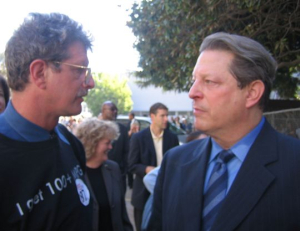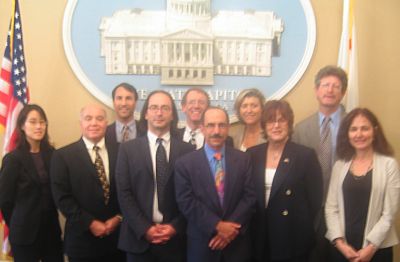
|
NOTE: This page is long overdue for an update. "...there are already some solutions that seem to stand out as particularly promising [...] We could further increase the value and efficiency of a distributed energy network by retooling our failing auto giants - GM and Ford - to require and assist them in switching to the manufacture of flex-fuel, plug-in, hybrid vehicles...." CalCars Founder Felix Kramer had a few minutes to talk with Al Gore about PHEVs and global warming after a speech in October 2006, before he returned to the Oakland airport in our car. Gore's top questions were about cost and availability. (More photos) |
CalCars and Global Warming: A Personal Evolution
This page gathers resources we draw on to demonstrate the critical role of PHEVs in moving to a low-carbon world. In California, transportation accounts for over 40% of greenhouse gas emissions. Nationally the number is around 33%. Globally it's 20% and rising fast, especially as car-starved China, India and Russia add to their fleets.
Note: We are frequently asked about the increased emissions from a "dirty" electrical grid being used to power PHEVs. Please see our All About Plug-In Hybrids page for more information on how electric propulsion is cleaner even from a coal-powered grid.
"The plug-in hybrid approach, as being pursued by CalCars, seems to be our best bet for controlling vehicle CO2 emissions in the near-term. Vehicle emissions are the greatest challenge that we must overcome to stabilize climate."
--James Hansen, Director of the NASA Goddard Institute for Space Studies and one of the world's leading experts on global warming
On the day the Kyoto Protocols took effect, I presented some ideas about how to create a sense of urgency in an Op Ed, Kyoto and Beyond, Feb. 14, 2005
My personal motivation for promoting gas-optional hybrids has evolved from general environmental/clean air goals to seeing GO-HEVs as a keystone component of a strategy to address global warming both nationally and internationally.
PHEVs charged from off-peak electricity from a modernized grid and from distributed photovoltaic and wind power, with the range extension engine powered by cellulose ethanol, appear to be the most promising way tomove toward eliminating carbon emissions from transportation.
We need to re-think all the "practical" calculations about paybacks and benefits as we acknowledge the urgency of a global transformation. "Commercialization" (high-volume production and distribution) of renewable products is all about strategies that create all types of incentives (econonomic, social and moral) to transform markets. CalCars is an example of those processes.
I had known the generalities about greenhouse gases for years, but it wasn't until I dug into the literature to prepare for the hearing, September 23, 2004 in Los Angeles on Implementation of AB1493 (the Pavley bill to reduce greenhouse gas emissions) that I really understood its impact. Here's CalCars' testimony at the hearing on Implementation of AB1493. Following its enactment, the California Air Resource Boards (CARB) was directed to consider ways to implement the law.
The staff's "Initial Statement of Reasons for Proposed Rulemaking" -- long and based on complex assumptions -- shows plug-in hybrids as one of the most effective solutions; we describe PHEVs as "the elephant in the room" that can accomplish far more than other steps. (Transcript includes supportive comments from Board Members.) Even on the national (50%) coal grid, PHEVs can reduce greenhouse gases by over 40% compared to gasoline cars (see Section 3 of CalCars' Vehicles page).
In a talk mainly to engineers about to enter the workforce at the national conference of Engineers for a Sustainable World, Oct. 1, 2004 at Stanford University, I focused on global warming and urged engineering grads to look for jobs that could help address the crisis: outline notes and slides (8MB PDF).
In fall 2004, I found the best single document was the enormously influential 5- page article by Richard Socolow and Stephen Pacala of Princeton University from Science Magazine August 2004: Stabilization Wedges: Solving the Global Cliimate Problem for the Next 50 years with Current Technologies or alternate site. See a quick introduction to the wedge strategy at Stabilizing the Global Greenhouse May Not Be So Hard, Christian Science Monitor, August 13, 2004.
I've found the best single online source of information about global warming is Real Climate, a technical-oriented site in the tradition of scientific peer review. And the original authoritative source is the Intergovernmental Panel on Climate Change (IPCC).
I'm often asked to explain how Newsweek's Fareed Zakaria and others say PHEVs can get us to cars that gett 500MPG of gasoline (plus other liquid fuels and electricity). (And how PHEVs that can run E-85 (15% gasoline, 85% ethanol) can be 300MPG gasoline cars.) This has led me to learn more about cellulose ethanol. This fuel from switchgrass, corn bagass and other plants can approach "zero-carbon" -- i.e. greenhouse gases produced in growing, harvesting and refining can be offset by the CO2 absorbed by the biomass as it grows. One good introduction to the field, which cites the main reports, describes the economics and land areas needed, and describes the companies involved in commercialization is Creating Cellulose Ethanol: Spinning Straw into Fuel (April 2005). The Natural Resource Defense Council's December 2004 Report, Growing Energy, is a good explanation, as is the US Energy Information Agency's Outlook for Biomass Ethanol Production and Demand (from 2000?).
One excellent explanation and rebuttal to the erroneous and simplified critiques that gained much attention in July 2005 comes from Anna Halpern-Lande. Another, from the American Council on Ethanol. For some of the practical issues about ethanol in cars, see an Illinois newspaper article. You can find links to resources and discussion groups on cellulose ethanol at Biofuel Info.
Many other promising new technologies could be explored, but are hindered by lack of capital and public attention. I'm especially intrigued by SolarMission Technologies' "Solar Tower" -- a zero-carbon solution that, if proven, could clean the grid rapidly anywhere in the world. (I'd like to hear from you if you can see technical or economic flaws.) Know anyone with a spare $0.5 billion?
For reactions to a reconsideration of an expansion of support for nuclear power in response to concerns about global warming, see the April 17-May 5, 2005 exchanges between Joseph Romm and Stewart Brand. See Also Amory Lovins' Competitors to Nuclear: Eat My Dust, an overview of the competition between renewable and nuclear power.
A MUST-READ: Elizabeth Kolbert's three-part series, "The Climate of Man." Start from Part 1 in the April 25 New Yorker or download a 32-page printable PDF document from CalCars. These articles form the basis for her new book, "Field Notes from a Catastrophe."
For "the other side of the story" see "How the Wall Street Journal and Rep. Barton Celebrated a Global Warming Skeptic," from Environmental Science & Technology, August 31, 2005.
Soon we'll see screening dates for the new film, An Inconvenient Truth, that includes much of the informative and energizing presentation that former Vice-President Al Gore has been delivering around the country for the past year.
(Gore is working to re-brand the inadequate phrases, "climate change" and "global warming" as "climate crisis." And in Britain, they're trying out "climate chaos.")




